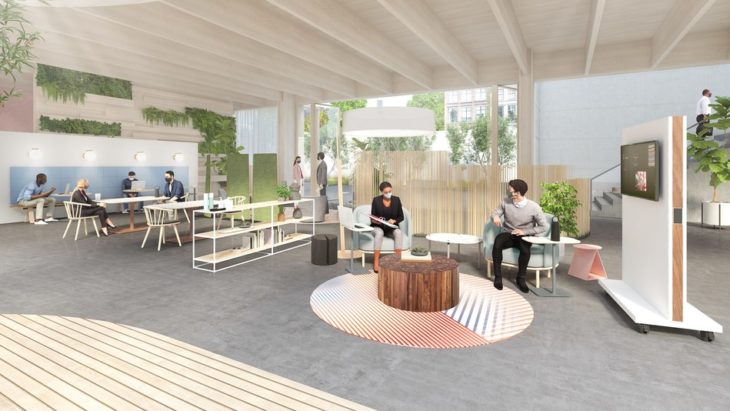How to Hybrid: Steelcase Global Report Reveals New Employee Needs for the Future Work Experience


New data reveals four innovative design strategies that integrate the best of both worlds – the comforts and convenience of home with the community, cultural and productivity benefits of the office.
A new global report released today from Steelcase highlights what workers need to feel safe and comfortable returning to the office near-term, and what they will want in their office going forward. The report, Changing Expectations and the Future of Work, finds 87% of business leaders plan to allow more flexibility around how, when and where people work, up 38% from April 2020. Only 5% of organizations expect to work from home full time while the vast majority, 72%, will take a hybrid approach – working from both home and office to offer greater flexibility to their employees. That will have major implications for office space, with 86% of businesses planning to shift their long-term real estate strategy. As business leaders navigate these changes, the Steelcase report showcases how organizations can design their workplaces for this new world of work.
To understand how the pandemic has impacted what people need and expect in the office, Steelcase researchers engaged over 32,000 people in multiple studies conducted in 10 countries over the course of the pandemic. Synthesizing this research uncovered five overarching needs that will drive new ways of planning and designing offices: employees need to be and feel safe; feel a deep sense of belonging; be productive; be physically, cognitively and emotionally comfortable; and have control over where and how they work.
“Leaders want people to be together, but their old office won’t work for the new reality,” said Gale Moutrey, vice president of workplace innovation. “Now is the time for companies to seize the opportunity to reinvent the work experience and the workplace. This report shows employees don’t want to return to the office they had before; they want to return to something better.”
Four Design Strategies for a Hybrid Workplace The report highlights four ideas to help organizations design their hybrid workplace and support the new employee expectations:
Balance the Needs of “We” and “Me”: While a common narrative says people want to work in the office primarily for group or social activities, Steelcase data shows employees also want the ability to focus and work in a quiet professional environment. When asked, leaders and employees alike listed both collaboration and focus in their top reasons for returning to the office. People shared the need to be able to quickly shift between working together and alone, and between more structured work and informal interactions.
Shift from Fixed-to-Fluid: The report finds people in every country reported improved autonomy and work-life balance while working from home, while struggling with productivity. Leaders can better support employees in the office by creating workspaces that are designed for greater flexibility, giving workers control over their environment. Pre-pandemic, the majority of people wanted to be able to reconfigure their furniture, but only 38% were able to do so. This means equipping workers with highly mobile furniture, power, technology and space division.
Flip Enclosed + Open Spaces: Perhaps one of the largest changes happening in the office is a shift from offering mostly enclosed collaborative spaces, such as conference rooms, to providing more open and flexible team spaces. Meanwhile, spaces for individual, focused work will shift from dense, open spaces to more enclosed or shielded places for privacy. This provides teams with both a sense of safety and the flexibility to resize their space based on activities.
Braid the Physical and the Digital Experience: As individuals and teams continue to live and work on video, employees will need places to join video conferences without disturbing others in the office. Teams will need to integrate space and technology to create inclusive experiences for those in the office and remote team members.
“Our research finds that taking a laissez-faire approach and simply returning to the pre-pandemic workplace will leave employees frustrated, reduce productivity and create inequities,” continued Moutrey. “The need to get it right has never been greater. The organizations that use this moment to create a better experience for their people will be the ones that emerge from this crisis ready to compete and win.”


About the Research
Since the onset of the pandemic, Steelcase has committed to conducting ongoing research to help organizations understand what is really happening to their workforce and the impact it is having on their business. The Steelcase data includes findings from eight qualitative and quantitative primary research studies conducted in 2020. This work was designed to measure the impact the COVID-19 pandemic has had on work, workers and the workplace. The studies were fielded in as many as 10 countries and have included more than 32,000 participants around the world using methodologies based in the social sciences.
About Steelcase
Leading organizations around the world trust Steelcase to help them create workplaces that help people feel safe and are productive, inspiring and adaptable with our architecture, furniture and technology solutions – accessible through a network of channels, including over 800 Steelcase dealer locations. Steelcase is a global, industry-leading, and publicly traded company with fiscal 2020 revenue of $3.7 billion. For more information, visit www.steelcase.com.





